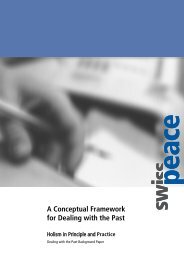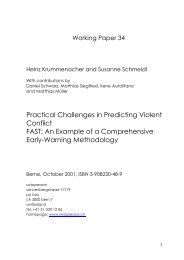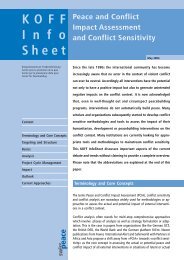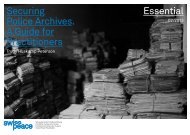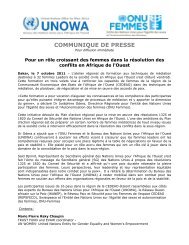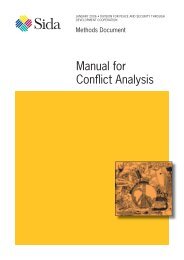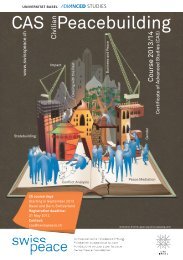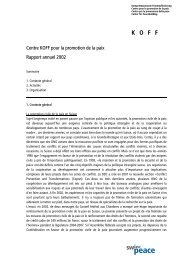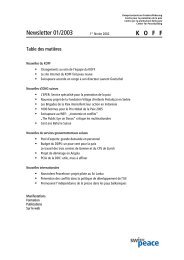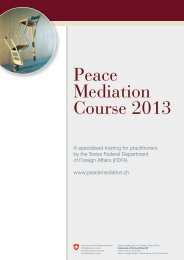Unpacking the Mystery of Mediation in African Peace ... - Swisspeace
Unpacking the Mystery of Mediation in African Peace ... - Swisspeace
Unpacking the Mystery of Mediation in African Peace ... - Swisspeace
You also want an ePaper? Increase the reach of your titles
YUMPU automatically turns print PDFs into web optimized ePapers that Google loves.
<strong>Unpack<strong>in</strong>g</strong> <strong>the</strong> <strong>Mystery</strong> <strong>of</strong> <strong>Mediation</strong> <strong>in</strong> <strong>African</strong> <strong>Peace</strong> Processes<br />
tested. One <strong>of</strong> <strong>the</strong> “tests” consisted <strong>in</strong> engag<strong>in</strong>g<br />
<strong>the</strong> parties to agree on a humanitarian cease-fire<br />
<strong>in</strong> a limited region <strong>in</strong> Sudan. The Nuba Mounta<strong>in</strong>s<br />
region was chosen as an area that had been<br />
ravaged by war, but was not a strategic area for ei<strong>the</strong>r<br />
<strong>of</strong> <strong>the</strong> two ma<strong>in</strong> conflict parties. This made<br />
compromises more likely. It is plausible that <strong>the</strong><br />
GoS engaged <strong>in</strong> <strong>the</strong>se talks because <strong>the</strong>y feared<br />
that if <strong>the</strong>y did not show goodwill, <strong>the</strong> US would<br />
militarily attack <strong>the</strong> country. 201<br />
Mediat<strong>in</strong>g <strong>the</strong> Nuba Mounta<strong>in</strong>s Ceasefire<br />
Agreement<br />
The Nuba Mounta<strong>in</strong>s ceasefire negotiations took<br />
place at Bürgenstock <strong>in</strong> Switzerland and lasted six<br />
days, mediated by a Swiss-US team under <strong>the</strong><br />
leadership <strong>of</strong> <strong>the</strong> Swiss Ambassador Josef Bucher.<br />
Bucher had close contacts with <strong>the</strong> Sudanese that<br />
dated back to 1994, one reason why <strong>the</strong>y wanted<br />
<strong>the</strong> Swiss <strong>in</strong>volved. The talks were attended by<br />
three <strong>of</strong>ficers, a legal advisor, and two diplomats<br />
from each government. As part <strong>of</strong> <strong>the</strong> procedure,<br />
it was agreed to avoid direct contacts between <strong>the</strong><br />
two conflict parties at first, but ra<strong>the</strong>r to have<br />
separate parallel meet<strong>in</strong>gs, <strong>the</strong> one side deal<strong>in</strong>g<br />
with <strong>the</strong> military questions, <strong>the</strong> o<strong>the</strong>r with political/legal<br />
questions, and <strong>the</strong>n chang<strong>in</strong>g over.<br />
When fac<strong>in</strong>g deadlock, <strong>the</strong> Swiss-US team came<br />
up with a concrete proposal as to where <strong>the</strong> various<br />
troops should be pulled back to. The proposal<br />
shocked both <strong>the</strong> GoS and <strong>the</strong> SPLM/A. It<br />
allowed for progress, however, as <strong>the</strong> parties had<br />
to lay more <strong>of</strong> <strong>the</strong>ir cards on <strong>the</strong> table <strong>in</strong> <strong>the</strong><br />
process <strong>of</strong> correct<strong>in</strong>g <strong>the</strong> proposal. After six days<br />
<strong>of</strong> talks, <strong>the</strong> six-month cease-fire (later prolonged)<br />
was signed at midday, on 19 January 2002. 202<br />
Negotiation Phase<br />
<strong>Mediation</strong> Team and Third Parties<br />
Involved<br />
Many third parties were <strong>in</strong>volved <strong>in</strong> <strong>the</strong> peace<br />
process. As <strong>of</strong> 2002, <strong>the</strong> IGAD talks were led by<br />
Kenyan Special Envoy General Sumbeiywo. Jul-<br />
201 Mason (2007): op. cit.<br />
202 Bucher, Josef: “E<strong>in</strong>e Nische für den Frieden“, <strong>in</strong>: Altwegg, Jürg,<br />
ed., Helvetia im Aussendienst, was Schweizer <strong>in</strong> der Welt Bewegen,<br />
München, Wien: Nagel & Kimche (2004), pp. 45-59.<br />
74<br />
ian T. Hott<strong>in</strong>ger, an expert work<strong>in</strong>g first at <strong>the</strong><br />
Institute <strong>of</strong> Federalism 203 and as <strong>of</strong> December<br />
2003 for <strong>the</strong> Swiss Foreign M<strong>in</strong>istry, was asked to<br />
jo<strong>in</strong> <strong>the</strong> IGAD mediation team, no least because<br />
<strong>of</strong> his experience <strong>in</strong> mediat<strong>in</strong>g <strong>the</strong> Nuba Mounta<strong>in</strong>s<br />
ceasefire. Fur<strong>the</strong>rmore, Nicholas ‘F<strong>in</strong>k’<br />
Haysom, a South <strong>African</strong> was part <strong>of</strong> <strong>the</strong> team.<br />
The role <strong>of</strong> <strong>the</strong> chief mediator Lt. General Sumbeiywo<br />
204 was to ma<strong>in</strong>ta<strong>in</strong> <strong>the</strong> respect for <strong>the</strong><br />
process, keep th<strong>in</strong>gs toge<strong>the</strong>r and step <strong>in</strong> at key<br />
moments; he was <strong>the</strong> doorkeeper to <strong>the</strong> process.<br />
His role has also been described as creat<strong>in</strong>g a<br />
“spider’s web” to protect <strong>the</strong> process, allow<strong>in</strong>g<br />
useful people to participate, o<strong>the</strong>rs to observe,<br />
and keep<strong>in</strong>g people who were not helpful out <strong>of</strong><br />
<strong>the</strong> process. There was enormous <strong>in</strong>ternational<br />
pressure on <strong>the</strong> mediators from <strong>the</strong> side <strong>of</strong> <strong>the</strong> <strong>in</strong>ternational<br />
community. Therefore, <strong>the</strong> role <strong>of</strong><br />
protect<strong>in</strong>g <strong>the</strong> process from <strong>in</strong>fluence on <strong>the</strong> content<br />
was essential to <strong>the</strong> success <strong>of</strong> <strong>the</strong> process.<br />
Hott<strong>in</strong>ger and Haysom dealt more with <strong>the</strong> nuts<br />
and bolts dur<strong>in</strong>g <strong>the</strong> sessions. The IGAD team<br />
fur<strong>the</strong>r consisted <strong>of</strong> three special IGAD envoys<br />
(from Eritrea, Ethiopia, and Uganda) who knew<br />
<strong>the</strong> parties extremely well, and a secretariat <strong>of</strong> five<br />
people. The process was led by <strong>the</strong> Intergovernmental<br />
Authority on Development (IGAD), but<br />
supported by a troika <strong>of</strong> <strong>the</strong> US, <strong>the</strong> UK, and<br />
Norway. Norway and EU were key f<strong>in</strong>ancers <strong>of</strong><br />
<strong>the</strong> process, and <strong>the</strong> UN took on <strong>the</strong> implementation<br />
role. 205<br />
<strong>Mediation</strong> Style and Third-Party<br />
Coord<strong>in</strong>ation<br />
The <strong>in</strong>ternational community had roughly managed<br />
to agree that <strong>the</strong>re was only one process and<br />
one facilitator <strong>in</strong>volved <strong>in</strong> <strong>the</strong> Sudan North-<br />
South conflict, and that no parallel exercise or<br />
process would be created. 206 The Sudan North-<br />
203 University <strong>of</strong> Fribourg, Switzerland, (http://www.federalism.ch).<br />
204 See also: Waihenya, Waithaka, The Mediator. Gen. Lazaro<br />
Sumbeiywo and <strong>the</strong> Sou<strong>the</strong>rn Sudan <strong>Peace</strong> Process, East <strong>African</strong><br />
Educational Publishers (2006).<br />
205 Mason (2007): op. cit.<br />
206 Hott<strong>in</strong>ger, Julian: “Mediat<strong>in</strong>g A <strong>Peace</strong> Agreement at <strong>the</strong> Beg<strong>in</strong>n<strong>in</strong>g<br />
<strong>of</strong> <strong>the</strong> 21st Century”, work<strong>in</strong>g paper, Swiss Federal Department<br />
<strong>of</strong> Foreign Affairs and <strong>Mediation</strong> Support Project<br />
(Center for Security Studies, Swiss Federal Institute <strong>of</strong> Technology<br />
(ETH) /swisspeace), unpublished (2008), p. 20.




